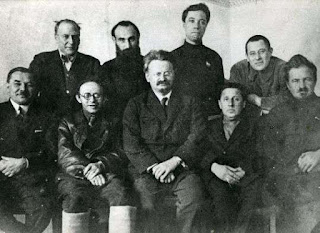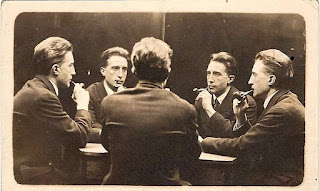What is surrealism? Did it only develop in
painting? Who were the representatives of the movement? André Breton, Salvador Dalí and René
Magritte are named as founders and expanders of these, and other, ideas
that started at the beginning of the 20th century.
En vocabulario: unnerving, non sequitur, foremost.
Para saber: Dada
Salvador Dalí and René Magritte
created the most widely recognized images of the movement. Dalí joined the group in 1929, and participated in the rapid
establishment of the visual style between 1930 and 1935…
Surrealism was a cultural movement which developed in Europe in the aftermath of World War I and was largely influenced
by Dada.
The movement is best known for its visual artworks and writings and
the juxtaposition of uncommon imagery. Artists painted unnerving, illogical scenes,
sometimes with photographic precision, creating strange creatures from everyday
objects, and developing painting techniques that allowed the unconscious to
express itself.
Works of surrealism feature the element of
surprise, unexpected juxtapositions and non
sequitur; however, many surrealist artists and writers regard their
work as an expression of the philosophical movement first and foremost, with the works
themselves being an artifact.
 |
| Dada artists, Paris, 1920 |
However, the Surrealist movement was not officially
established until October 15, 1924, when the French poet and critic André
Breton published the Surrealist
Manifesto in Paris. The most
important center of the movement was Paris,
France. From the 1920s onward, the movement spread around the globe,
impacting the visual arts, literature, film, and music of many countries and
languages, as well as political thought and practice, philosophy, and social
theory.
The movement in
the mid-1920s was characterized by meetings in cafes where the Surrealists played collaborative drawing
games, discussed the theories of Surrealism,
and developed a variety of techniques such as automatic drawing.
Surrealism and international politics
Politically, Surrealism was Trotskyist,
communist, or anarchist.
Breton and his comrades supported Leon Trotsky and his International Left Opposition for a
while, though there was an openness to anarchism that manifested more fully
after World War II. Dalí supported capitalism and the
fascist dictatorship of Francisco Franco
but cannot be said to represent a trend in Surrealism
in this respect; in fact he was considered, by Breton and his associates, to have betrayed and left Surrealism.
 |
| Left opposition, 1927 |
Surrealists have often sought to link their efforts with
political ideals and activities. In the Declaration of January 27, 1925, for
example, members of the Paris-based Bureau of Surrealist Research declared
their affinity for revolutionary politics.
While this was
initially a somewhat vague formulation, by the 1930s many Surrealists had strongly identified themselves with communism.
In 1925, the Paris Surrealist group and the extreme
left of the French Communist Party came
together to support Abd-el-Krim,
leader of the Rif uprising against French colonialism in Morocco.
Golden age
 |
| Magritte, The treachery of images |
Salvador Dalí and René Magritte
created the most widely recognized images of the movement. Dalí joined the group in 1929, and participated in the rapid
establishment of the visual style between 1930 and 1935.
Surrealism as a visual movement had found a method: to expose
psychological truth; stripping ordinary objects of their normal significance,
to create a compelling image that was beyond ordinary formal organization, in
order to evoke empathy from the viewer.
Para saber
Dada
(/ˈdɑːdɑː/) or Dadaism was an art
movement of the European avant-garde
in the early 20th century, with early centers in Zürich, Switzerland, at the Cabaret
Voltaire (circa 1916). Developed in reaction to World War I, the Dada
movement consisted of artists who rejected the logic, reason, and
aestheticism of modern capitalist society, instead expressing nonsense,
irrationality, and anti-bourgeois protest in their works. The art of the
movement spanned visual, literary, and sound media, including collage, sound
poetry, cut-up writing, and sculpture. Dadaist
artists expressed their discontent toward violence, war, and nationalism,
and maintained political affinities with the radical far-left.
 |
| Five way portrait, Marcel Duchamp |
The Dadaist movement included public gatherings, demonstrations, and
publication of art/literary journals; passionate coverage of art, politics, and
culture were topics often discussed in a variety of media. Key figures in the
movement included Jean Arp, Johannes
Baader, Hugo Ball, Marcel Duchamp, Max Ernst, Elsa von Freytag-Loringhoven,
George Grosz, Raoul Hausmann, John Heartfield, Emmy Hennings, Hannah Höch,
Richard Huelsenbeck, Francis Picabia, Man Ray, Hans Richter, Kurt Schwitters,
Sophie Taeuber-Arp, Tristan Tzara, and Beatrice Wood, among others. The
movement influenced later styles like the avant-garde and downtown music
movements, and groups including Surrealism,
nouveau réalisme, pop art and Fluxus.
Vocabulario
Unnerving: disconcerting.
A non sequitur /nɒn ˈsɛkwɪtər/ is a
conversational literary device, often used for comedic purposes. It is
something said that, because of its apparent lack of meaning relative to what
preceded it, seems absurd to the point of being humorous or confusing. A non sequitur can denote an
abrupt, illogical, or unexpected turn in plot or dialogue by including a
relatively inappropriate change in manner. A non sequitur joke sincerely has no explanation, but it reflects the
idiosyncrasies, mental frames and alternative world of the particular comic
persona.
Foremost: most prominent
in rank, importance, or position.
Artículos relacionados
As an
adolescent, he resisted the sexual advances by his girlfriend for five years… The
secret life of Salvador Dalí
… el presidente bebe Coca, Liz Taylor bebe Coca, y vos
también podés beber Coca Cola... Andy Warhol
… murió el 22 de enero de 1994, apenas un día
después de cumplir 72 años, de complicaciones de cáncer… Telly
Savalas
Fuentes
Surrealism,
From Wikipedia, the free encyclopedia
No comments:
Post a Comment